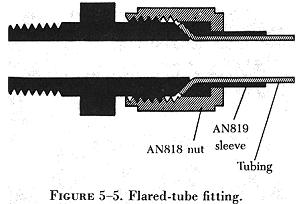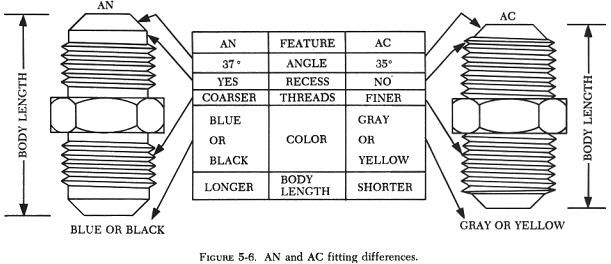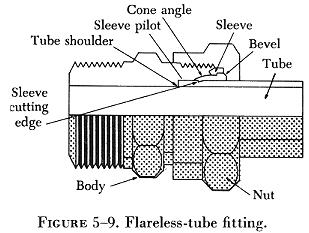PLUMBINGCONNECTORS
PLUMBING CONNECTORS
Plumbing connectors, or fittings, attach one piece of tubing to another
or to system units. There are four types: (1) Flared fitting, (2) flareless
fitting, (3) bead and clamp, and (4) swaged. The amount of pressure that
the system carries is usually the deciding factor in selecting a connector.
The beaded type of joint, which requires a bead and a section of hose and
hose clamps, is used only in low or medium pressure systems, such as vacuum
and coolant systems. The flared, flareless, and swaged types may be used
as connectors in all systems, regardless of the pressure.
Flared Tube Fittings
| A flared tube fitting consists of a sleeve and a nut, as shown in figure
5-5. The nut fits over the sleeve and, when tightened, draws the sleeve
and tubing flare tightly against a male fitting to form a seal. Tubing
used with this type of fitting must be flared before installation.
The male fitting has a cone shaped surface with the same angle as the
inside of the flare. The sleeve supports the tube so that vibration does
not concentrate at the edge of the flare, and distributes the shearing
action over a wider area for added strength. Tube flaring and the installation
of flared tube fittings are discussed in detail later in this chapter. |

|

The AC (Air Corps) flared tube fittings have been replaced by the AN
(Army/Navy) Standard and MS (Military Standard) fittings. However, since
AC fittings are still in use in some of the older aircraft, it is important
to be able to identify them. The AN fitting has a shoulder between the
end of the threads and the flare cone. (See figure 5-6.) The AC fitting
does not have this shoulder.
Other differences between the AC and AN fittings include the sleeve
design, the AC sleeve being noticeably longer than the AN sleeve of the
same size. Although certain flared tube fittings are interchangeable, the
pitch of the threads is different in most cases. Figures
5-7a and b show the AN and AC811 fittings that
can be safely interchanged. Combinations of end connections, nuts,
sleeves, and tube flares are allowed to make up a complete fitting assembly.
The use of dissimilar metals should be avoided since their contact will
cause corrosion. When combining AC and AN end connections, nuts, sleeves,
or tube flares, if the nut will not move more than two threads by hand,
stop and investigate for possible trouble.
The AN standard fitting is the most commonly used flared tubing assembly
for attaching the tubing to the various fittings required in aircraft plumbing
systems. The AN standard fittings include the AN818 nut and AN819 sleeve.
(See figure 5-8.) The AN819 sleeve is used with the
AN818 coupling nut. All these fittings have straight threads, but they
have different pitch for the various types.
Flared tube fittings are made of aluminum alloy, steel, or copper base
alloys. For identification purposes, all AN steel fittings are colored
black, and all AN aluminum alloy fittings are colored blue. The AN 819
aluminum bronze sleeves are cadmium plated and are not colored. The size
of these fittings is given in dash numbers, which equal the nominal tube
outside diameter (O.D.) in sixteenths of an inch.
Threaded flared tube fittings have two types of ends, referred to as
male and female. The male end of a fitting is externally threaded, whereas
the female end of a fitting is internally threaded.
| Flareless Tube Fittings
The MS (Military Standard) flareless tube fittings are finding wide
application in aircraft plumbing systems. Using this type fitting eliminates
all tube flaring, yet provides a safe, strong, dependable tube connection.
The fitting consists of three parts: a body, a sleeve, and a nut. The body
has a counterbored shoulder, against which the end of the tube rests. (See
figure 5-9.) The angle of the counterbore causes the cutting edge of the
sleeve to cut into the outside of the tube when the two are joined. Installation
of flareless tube fittings is discussed later in this chapter.
Quick Disconnect Couplings |

|
Quick disconnect couplings of the self-sealing type are used at various
points in many fluid systems. The couplings are installed at locations
where frequent uncoupling of the lines is required for inspection and maintenance.
Quick disconnect couplings provide a means of quickly disconnecting
a line without loss of fluid or entrance of air into the system. Each coupling
assembly consists of two halves, held together by a union nut. Each half
contains a valve that is held open when the coupling is connected, allowing
fluid to flow through the coupling in either direction. When the coupling
is disconnected, a spring in each half closes the valve, preventing the
loss of fluid and entrance of air.
The union nut has a quick lead thread which permits connecting or disconnecting
the coupling by turning the nut. The amount the nut must be turned varies
with different style couplings. One style requires a quarter turn of the
union nut to lock or unlock the coupling while another style requires a
full turn.
Some couplings require wrench tightening; others are connected and disconnected
by hand. The design of some couplings is such that they must be safetied
with safety wire. Others do not require lock wiring, the positive locking
being assured by the teeth on the locking spring, which engage ratchet
teeth on the union nut when the coupling is fully engaged. The lock spring
automatically disengages when the union nut is unscrewed. Because of individual
differences, all quick disconnects should be installed according to instructions
in the aircraft maintenance manual.
Flexible Connectors
Flexible connectors may be equipped with either swaged fittings or detachable
fittings, or they may be used with beads and hose clamps. Those equipped
with swaged fittings are ordered by correct length from the manufacturer
and ordinarily cannot be assembled by the mechanic. They are swaged and
tested at the factory and are equipped with standard fittings.
The fittings on detachable connectors can be detached and reused if
they are not damaged; otherwise new fittings must be used.
The bead and hose clamp connector is often used for connecting oil,
coolant, and low pressure fuel system tubing. The bead, a slightly raised
ridge around the tubing or the fitting, gives a good gripping edge that
aids in holding the clamp and hose in place. The bead may appear near the
end of the metal tubing or on one end of a fitting.


